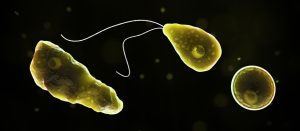This post is by Bernie Carr, apartmentprepper.com
Now that we are in the height of summer, water parks, lakes and rivers are popular spots to spend time with the family and cool off. Recently, a brain-eating amoeba claimed the life of a man who visited a water park in North Carolina. Statistically, the number of victims may be low, but that does not help the victim. It’s good to aware of this threat so everyone can take steps to protect themselves.
What are brain-eating amoebas?

Amoebas are single-celled living organisms. These dangerous amoebas, known as Naegleria fowleri, are parasites that live in freshwater bodies of water such as lakes, rivers, hot springs, ponds or creeks. They can also live in soil, under-treated swimming pools or even contaminated tap water.
How is it contracted?
If swallowed, nothing happens to the victim. The case becomes fatal if the organism enters the body through the nose. Once the amoeba enters the nose, it travels to the brain where it causes an infection of the brain called primary amebic meningoencephalitis (PAM). This disease is not spread from person to person.
How common is this disease?
According to the CDC, Naegleria fowleri infection is considered a “rare disease.” The definition of a rare disease is a disease that affects less than 200,000 people in the U.S.
“In the 10 years from 2009 to 2018, 34 infections were reported in the U.S. Of those cases, 30 people were infected by recreational water, 3 people were infected after performing nasal irrigation using contaminated tap water, and 1 person was infected by contaminated tap water used on a backyard slip-n-slide.”
Most cases of this disease occur in Southern or Southwestern states: more than half of all infections have been in Florida and Texas.
Symptoms:
The initial symptoms may include:
- headache
- fever
- nausea
- vomiting
Later symptoms can include stiff neck, confusion, lack of attention to people and surroundings, loss of balance, seizures, and hallucinations. This disease progresses rapidly and usually causes death within about 5 days.
According the CDC, people should seek medical care immediately whenever they develop a sudden onset of fever, headache, stiff neck, and vomiting, particularly if they have been in warm freshwater recently.
How do you avoid contracting Naegleria fowleri infection?
Avoid activities that can cause water to go up the nose such as diving or jumping into the water or swimming underwater especially in late summer when the water is warm.
Reduce the chance of this parasite entering the body by keeping the head above water and by using a nose plug, according to the Medical Director of Infectious Disease at Cooke Children’s Medical Center in Fort Worth, TX.
Wear a nose clip or plug when boating, swimming or playing in warm waters.
You should also avoiding digging up mud in shallow areas as it is present in soil.
When using a neti pot to cleanse your nostrils, Do not use tap water even if it’s filtered. Use distilled water instead.
Note: I am not a doctor or healthcare provider. This information is not meant to be to self-diagnose or as a substitute for consultation with a medical professional. If you think you have been exposed, you need to contact a health care provider as soon as possible.
If you found value in the article, please help us keep this site free by supporting Apartment Prepper on Patreon. Click here: https://www.patreon.com/apartmentprepper No worries if you are not able to, I’ll still keep writing!


